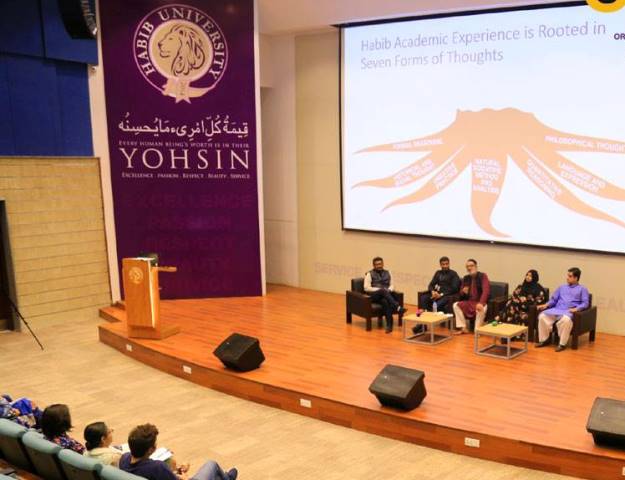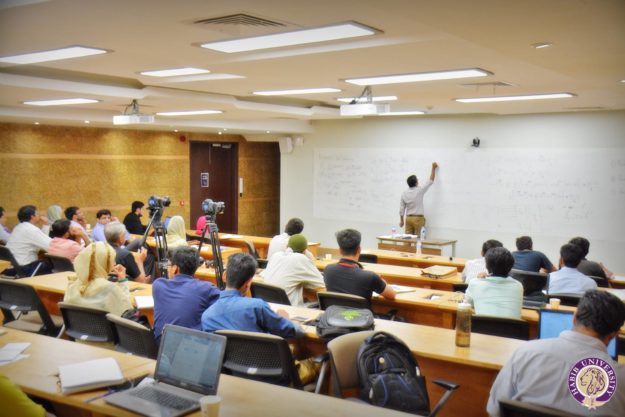Habib University: Redefining higher education through ‘student-centricity’
Explore how Habib University strives to cultivate a student-centric approach

The ever-evolving world is characterised by constant socio-economic flux and a unique set of challenges, reflected by a continuous recalibration of job roles and ‘in-demand’ career options. It seems like in order to really stand out, universities today need to incorporate these new realities in their blueprint and ensure that graduates possess the right set of skills and the mindset to navigate their way to success years from now.
Consequently, universities today need to prioritise students, foresee the requirements and challenges of the future and invest in providing an educational experience which is in sync with these realities. Any well-positioned and acclaimed institution of higher learning acquires its preeminence on the back of its direct beneficiaries and key representatives: students. So the best way to meet current expectations is to adopt a ‘student-centric’ approach. This student oriented view to university education lets students be in the driving seat of their undergraduate experience and enables them to take ownership of and customize their learning according to their interests and the needs of society.
 The concept of ‘student-centeredness’ is closely linked with that of ‘university planning and design’: for Habib University, key elements of an effective university plan include a robust mission, effective curriculum, quality faculty, institutional collaborations, resource mobilisation and infrastructure. Meticulous attention to these dimensions will ensure a student-oriented paradigm, providing them with an enriching and holistic university education.
The concept of ‘student-centeredness’ is closely linked with that of ‘university planning and design’: for Habib University, key elements of an effective university plan include a robust mission, effective curriculum, quality faculty, institutional collaborations, resource mobilisation and infrastructure. Meticulous attention to these dimensions will ensure a student-oriented paradigm, providing them with an enriching and holistic university education.
To begin with, a robust mission is key in determining a university’s approach and its ultimate success. At Habib University, its guiding principle states that ‘every individual’s self-worth is in their Yohsin (an Arabic word which translates into ‘thoughtful self-cultivation’). The mission of HU, informed by ‘Yohsin’, encourages students to strive for continuous self-development and to better understand their critical role as transformative agents in society. Placing students at the heart of the university the carefully crafted mission illustrates HU’s ‘intent’ to offer a unique, empowering undergraduate learning experience rooted in the ethos of personal and collective development.

Once the right intent is set, effective ‘planning’ operationalises the said mission into actionable objectives. Contrary to popular perception, a ‘student-centric’ approach is not a contest between a ‘research-oriented’ or a ‘teaching oriented’ paradigm to university education; rather, the ‘student-centric’ view allows students to be ‘co-creators’ and intellectual partners in their crucial undergraduate education experience.
In other words, student-centric planning would entail moving from a model of the student as a subject or the receiver of the pre-determined curricula. Rather, the student should direct their individualised learning journey, which sets the stage for lifelong learning and does not end with the acquisition of their undergraduate degree. The entire process should be driven by both the students’ own interests and aspirations and the demands of a knowledge economy.

At Habib University, curriculum development and intellectual programming are key components of the planning process. It ensures that students are able to plan their course of study and customise their learning experience through a range of electives, minors and experiential learning opportunities. HU also places great emphasis on recruiting highly qualified faculty from leading institutions around the world. The faculty plays a critical role in translating the unique curricular design into action and serve as a key source of inspiration for HU students.
It needs to be re-emphasised here that student-centeredness is not part of the teaching versus research debate. All student centeredness will require great teaching and great innovation in teaching, but not all teaching is necessarily student-centric. The learning community fostered by HU is one in which both faculty and student interests converge rather than diverge; it prioritises student learning and development by incorporating the right incentive structures for faculty to design and commit to engaging academic programming.

The importance of cultivating a network of partners in university planning cannot be overstressed in terms of its importance in shaping a student-centric university like HU. Sustained efforts on this front have meant that today, HU benefits from the support of a range of institutional partners around the world which include representatives from the industry, public sector and academic institutions which continue to guide and inform HU’s evolution as a leading Liberal Arts university. They do so by providing both intellectual and material resources for the betterment of the HU community and consequently, of society at large.
Finally, the physical design and infrastructure is critical in providing the most conducive platform for the execution of a thorough university plan. HU’s connected, multi-use and the interactive campus is designed to bring to life the interdisciplinary nature of the curriculum and to foster meaningful debate, critical thinking and creative output in HU’s learning community.
Through the aforementioned areas of university planning and design, HU strives to cultivate a student-centric approach to higher education and seeks to capitalise on its unique Liberal Arts model of higher education to produce critically conscious graduates who possess the skills, knowledge and passion to shape a better tomorrow for all.




















COMMENTS
Comments are moderated and generally will be posted if they are on-topic and not abusive.
For more information, please see our Comments FAQ